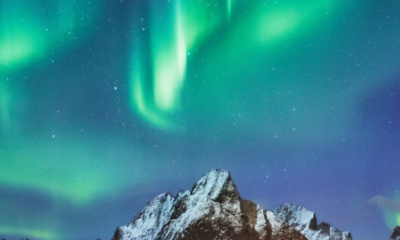WEATHER
The Benefits of Going to the Beach in Summer

The allure of the beach or a scenic sea view is undeniable, especially during the summer months when the sun shines bright and the weather beckons. Beyond the obvious appeal of sun, sand, and sea, spending time at the beach or enjoying a sea view offers a myriad of benefits for both physical and mental well-being. Let’s explore some of the compelling reasons why you should consider heading to the beach or seeking out a sea view this summer.
Health Benefits
Vitamin D Absorption
Basking in the sunlight at the beach allows your skin to absorb essential vitamin D, crucial for maintaining healthy bones and immune function. Vitamin D plays a vital role in calcium absorption, which is essential for bone health, reducing the risk of conditions like osteoporosis.
Stress Reduction
The soothing sound of waves crashing against the shore and the gentle sea breeze have a calming effect on the mind, reducing stress levels and promoting relaxation. Research has shown that spending time near water can lower cortisol levels, the hormone associated with stress, leading to improved overall well-being.
Improved Sleep Quality
Exposure to natural sunlight during the day helps regulate your circadian rhythm, leading to better sleep quality at night. The body’s internal clock, influenced by exposure to light and darkness, helps regulate sleep-wake cycles, and spending time outdoors during daylight hours can help synchronize this internal clock, leading to more restful sleep.
Physical Benefits
Exercise Opportunities
The beach provides a natural setting for various physical activities such as swimming, beach volleyball, or simply walking along the shore, helping you stay active and fit. Swimming is an excellent full-body workout that engages multiple muscle groups, improves cardiovascular health, and enhances flexibility and endurance.
Enhanced Skin Health
The mineral-rich seawater and exfoliating sand can have beneficial effects on your skin, promoting circulation and providing natural exfoliation. Additionally, the saltwater’s antimicrobial properties can help cleanse the skin and reduce the risk of infections, making it particularly beneficial for individuals with skin conditions like acne or eczema.
Respiratory Health Improvement
Breathing in the fresh sea air can help clear your airways and alleviate respiratory issues such as allergies or asthma. The sea breeze carries tiny salt particles and ions, which can help break up mucus and improve lung function, making it easier to breathe for individuals with respiratory conditions.
Mental Well-being
Mood Enhancement
The combination of sunshine, sea breeze, and the beauty of the natural surroundings can uplift your mood and enhance feelings of happiness and well-being. Sunlight exposure triggers the release of serotonin, often referred to as the “feel-good” hormone, which can help alleviate symptoms of depression and anxiety.
Relaxation and Rejuvenation
Immersing yourself in the tranquil environment of the beach allows you to disconnect from the stressors of daily life and recharge your batteries. The rhythmic sound of waves has a hypnotic effect that induces a state of relaxation, reducing muscle tension and promoting mental clarity and focus.
Creativity Boost
Many people find that being near the water stimulates their creativity and inspires new ideas and perspectives. The calming effect of the beach environment can quiet the mind’s chatter, allowing for greater mental clarity and the emergence of creative insights and solutions.
Social Connection
Bonding with Family and Friends
The beach offers a perfect setting for spending quality time with loved ones, whether it’s building sandcastles with children or enjoying a picnic with friends. Shared experiences in a natural, unstructured environment strengthen bonds and create lasting memories that can be cherished for years to come.
Community Engagement
Beach outings often involve interacting with other beachgoers, fostering a sense of community and belonging. Whether it’s joining a beach cleanup event or participating in a beach volleyball tournament, the beach provides opportunities to connect with like-minded individuals and contribute to the local community.
Nature Appreciation
Scenic Beauty
From breathtaking sunsets to the mesmerizing sight of waves crashing against the shore, the beach offers unparalleled natural beauty. The ever-changing coastal landscape, shaped by tides and weather patterns, provides a constant source of awe and inspiration for beachgoers of all ages.
Wildlife Observation
Beach ecosystems are teeming with diverse marine life, providing opportunities for wildlife enthusiasts to observe and appreciate nature up close. From playful dolphins and majestic seabirds to colorful tide pool inhabitants, the beach offers a rich tapestry of biodiversity waiting to be explored and admired.
Environmental Awareness
Spending time in nature fosters a deeper appreciation for the environment and encourages responsible stewardship of natural resources. Beach conservation initiatives, such as dune restoration projects and sea turtle monitoring programs, raise awareness about the importance of preserving fragile coastal ecosystems for future generations to enjoy.
Safety Measures
Sun Protection
While enjoying the beach, it’s essential to protect your skin from harmful UV rays by wearing sunscreen, hats, and sunglasses. Sunscreen should be reapplied every two hours, especially after swimming or sweating, and seek shade during peak sun hours to minimize sun exposure.
Water Safety
Be mindful of water safety guidelines and always swim in designated areas with lifeguards present to prevent accidents and injuries. Avoid swimming alone, especially in unfamiliar or hazardous conditions, and teach children basic water safety skills such as floating and treading water.
Hydration
Spending time in the sun and sea can lead to dehydration, so be sure to drink plenty of water to stay hydrated. Pack a reusable water bottle and drink fluids regularly, even if you don’t feel thirsty, to prevent dehydration and maintain optimal physical and cognitive function.
Accessibility and Affordability
Public Beach Access
Many beaches offer free or low-cost access, making it an accessible recreational option for people of all ages and backgrounds. Public beaches often provide amenities such as restrooms, picnic areas, and lifeguard services, ensuring a safe and enjoyable experience for beachgoers.
Budget-friendly Option
Compared to other summer activities, such as amusement parks or vacations, a day at the beach is relatively affordable, requiring minimal expenses. Pack a cooler with snacks and beverages, bring your own beach gear, and take advantage of free or discounted parking options to minimize costs and maximize enjoyment.
Conclusion
Whether you’re looking to improve your physical health, enhance your mental well-being, or simply enjoy some leisure time with loved ones, spending time at the beach or soaking in a sea view offers a plethora of benefits. So, why not make the most of the summer season by embracing the joys of beach life.
FAQs
Is it safe to swim in the ocean during the summer?
Swimming in the ocean is generally safe during the summer months, but it’s essential to be aware of water conditions and any potential hazards such as rip currents. Always swim in designated areas with lifeguards present, and avoid swimming alone or in rough surf conditions.
What should I pack for a day at the beach?
Essentials include sunscreen (SPF 30 or higher), hats, sunglasses, water bottles, snacks, towels, and beach chairs or blankets. Don’t forget to bring a beach umbrella or sunshade for added sun protection and shade.
Are there any health risks associated with spending too much time in the sun?
Prolonged sun exposure without protection can increase the risk of sunburn, skin cancer, and heat-related illnesses such as heat exhaustion or heatstroke. It’s crucial to practice sun safety measures, including wearing sunscreen, seeking shade, and staying hydrated.
How can I stay safe while swimming in the ocean?
Always swim in designated areas with lifeguards present, avoid swimming alone, and be mindful of water conditions and currents. Check local beach advisories and signage for any warnings or restrictions, and never swim under the influence of alcohol or drugs.
What are some alternative activities to enjoy at the beach besides swimming?
Beachcombing, building sandcastles, playing beach games (e.g., frisbee, paddleball), and simply relaxing and soaking in the scenery are all popular beach activities. Consider bringing along a snorkel and mask to explore the underwater world or joining a guided nature walk to learn more about the coastal ecosystem.
WEATHER
Snowfall: Embracing the Winter Wonderland
-

 LIFE STYLE11 months ago
LIFE STYLE11 months agoPurenudism: Embracing a Natural Lifestyle
-

 GENERAL8 months ago
GENERAL8 months agoAurora Lights:Unveiling Exploring Guide Line
-

 GENERAL8 months ago
GENERAL8 months agoMoonlight: A Comprehensive Exploration to Moonlight
-

 GENERAL6 months ago
GENERAL6 months agoThe Grand Wedding of the Ambanis: A Spectacle of Love and Luxury
-

 FASHION8 months ago
FASHION8 months agoTail Frock : A Comprehensive Guide
-

 HEALTH10 months ago
HEALTH10 months agoEverything You Need To Know About Wellhealth: How to Build Muscle Tag
-

 APPS11 months ago
APPS11 months agoCapCut: Revolutionizing Video Editing for All
-

 PRODUCTS12 months ago
PRODUCTS12 months agoUnveiling the Magic of Wow Hair Products: A Comprehensive Guide

